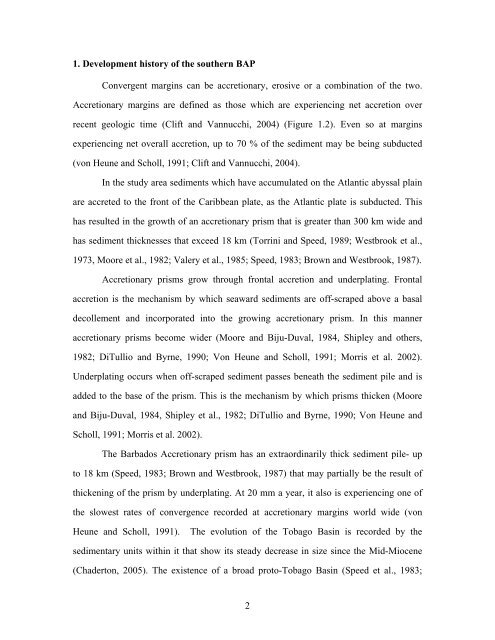Copyright by Nysha Chaderton 2009 - The University of Texas at ...
Copyright by Nysha Chaderton 2009 - The University of Texas at ...
Copyright by Nysha Chaderton 2009 - The University of Texas at ...
Create successful ePaper yourself
Turn your PDF publications into a flip-book with our unique Google optimized e-Paper software.
1. Development history <strong>of</strong> the southern BAP<br />
Convergent margins can be accretionary, erosive or a combin<strong>at</strong>ion <strong>of</strong> the two.<br />
Accretionary margins are defined as those which are experiencing net accretion over<br />
recent geologic time (Clift and Vannucchi, 2004) (Figure 1.2). Even so <strong>at</strong> margins<br />
experiencing net overall accretion, up to 70 % <strong>of</strong> the sediment may be being subducted<br />
(von Heune and Scholl, 1991; Clift and Vannucchi, 2004).<br />
In the study area sediments which have accumul<strong>at</strong>ed on the Atlantic a<strong>by</strong>ssal plain<br />
are accreted to the front <strong>of</strong> the Caribbean pl<strong>at</strong>e, as the Atlantic pl<strong>at</strong>e is subducted. This<br />
has resulted in the growth <strong>of</strong> an accretionary prism th<strong>at</strong> is gre<strong>at</strong>er than 300 km wide and<br />
has sediment thicknesses th<strong>at</strong> exceed 18 km (Torrini and Speed, 1989; Westbrook et al.,<br />
1973, Moore et al., 1982; Valery et al., 1985; Speed, 1983; Brown and Westbrook, 1987).<br />
Accretionary prisms grow through frontal accretion and underpl<strong>at</strong>ing. Frontal<br />
accretion is the mechanism <strong>by</strong> which seaward sediments are <strong>of</strong>f-scraped above a basal<br />
decollement and incorpor<strong>at</strong>ed into the growing accretionary prism. In this manner<br />
accretionary prisms become wider (Moore and Biju-Duval, 1984, Shipley and others,<br />
1982; DiTullio and Byrne, 1990; Von Heune and Scholl, 1991; Morris et al. 2002).<br />
Underpl<strong>at</strong>ing occurs when <strong>of</strong>f-scraped sediment passes bene<strong>at</strong>h the sediment pile and is<br />
added to the base <strong>of</strong> the prism. This is the mechanism <strong>by</strong> which prisms thicken (Moore<br />
and Biju-Duval, 1984, Shipley et al., 1982; DiTullio and Byrne, 1990; Von Heune and<br />
Scholl, 1991; Morris et al. 2002).<br />
<strong>The</strong> Barbados Accretionary prism has an extraordinarily thick sediment pile- up<br />
to 18 km (Speed, 1983; Brown and Westbrook, 1987) th<strong>at</strong> may partially be the result <strong>of</strong><br />
thickening <strong>of</strong> the prism <strong>by</strong> underpl<strong>at</strong>ing. At 20 mm a year, it also is experiencing one <strong>of</strong><br />
the slowest r<strong>at</strong>es <strong>of</strong> convergence recorded <strong>at</strong> accretionary margins world wide (von<br />
Heune and Scholl, 1991). <strong>The</strong> evolution <strong>of</strong> the Tobago Basin is recorded <strong>by</strong> the<br />
sedimentary units within it th<strong>at</strong> show its steady decrease in size since the Mid-Miocene<br />
(<strong>Chaderton</strong>, 2005). <strong>The</strong> existence <strong>of</strong> a broad proto-Tobago Basin (Speed et al., 1983;<br />
2
















